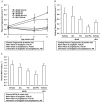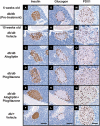Combining a dipeptidyl peptidase-4 inhibitor, alogliptin, with pioglitazone improves glycaemic control, lipid profiles and beta-cell function in db/db mice
- PMID: 19371350
- PMCID: PMC2707988
- DOI: 10.1111/j.1476-5381.2009.00145.x
Combining a dipeptidyl peptidase-4 inhibitor, alogliptin, with pioglitazone improves glycaemic control, lipid profiles and beta-cell function in db/db mice
Abstract
Background and purpose: Alogliptin, a highly selective dipeptidyl peptidase-4 (DPP-4) inhibitor, enhances incretin action and pioglitazone enhances hepatic and peripheral insulin actions. Here, we have evaluated the effects of combining these agents in diabetic mice.
Experimental approach: Effects of short-term treatment with alogliptin alone (0.01%-0.1% in diet), and chronic combination treatment with alogliptin (0.03% in diet) and pioglitazone (0.0075% in diet) were evaluated in db/db mice exhibiting early stages of diabetes.
Key results: Alogliptin inhibited plasma DPP-4 activity up to 84% and increased plasma active glucagon-like peptide-1 by 4.4- to 4.9-fold. Unexpectedly, alogliptin alone lacked clear efficacy for improving glucose levels. However, alogliptin in combination with pioglitazone clearly enhanced the effects of pioglitazone alone. After 3-4 weeks of treatment, combination treatment increased plasma insulin by 3.8-fold, decreased plasma glucagon by 41%, both of which were greater than each drug alone, and increased plasma adiponectin by 2.4-fold. In addition, combination treatment decreased glycosylated haemoglobin by 2.2%, plasma glucose by 52%, plasma triglycerides by 77% and non-esterified fatty acids by 48%, all of which were greater than each drug alone. Combination treatment also increased expression of insulin and pancreatic and duodenal homeobox 1 (PDX1), maintained normal beta-cell/alpha-cell distribution in islets and restored pancreatic insulin content to levels comparable to non-diabetic mice.
Conclusions and implications: These results indicate that combination treatment with alogliptin and pioglitazone at an early stage of diabetes improved metabolic profiles and indices that measure beta-cell function, and maintained islet structure in db/db mice, compared with either alogliptin or pioglitazone monotherapy.
Figures







References
-
- Cejvan K, Coy DH, Efendic S. Intra-islet somatostatin regulates glucagon release via type 2 somatostatin receptors in rats. Diabetes. 2003;52(5):1176–1181. - PubMed
-
- Ceriello A. The possible role of postprandial hyperglycaemia in the pathogenesis of diabetic complications. Diabetologia. 2003;46(Suppl.)(1):M9–M16. - PubMed
-
- Ceriello A, Johns D, Widel M, Eckland DJ, Gilmore KJ, Tan MH. Comparison of effect of pioglitazone with metformin or sulfonylurea (monotherapy and combination therapy) on postload glycaemia and composite insulin sensitivity index during an oral glucose tolerance test in patients with type 2 diabetes. Diabetes Care. 2005;28(2):266–272. - PubMed
-
- Charpentier G. Oral combination therapy for type 2 diabetes. Diabetes Metab Res Rev. 2002;18(Suppl.)(3):S70–S76. - PubMed
-
- Deacon CF. Therapeutic strategies based on glucagon-like peptide 1. Diabetes. 2004;53(9):2181–2189. - PubMed
MeSH terms
Substances
LinkOut - more resources
Full Text Sources
Medical
Research Materials
Miscellaneous

